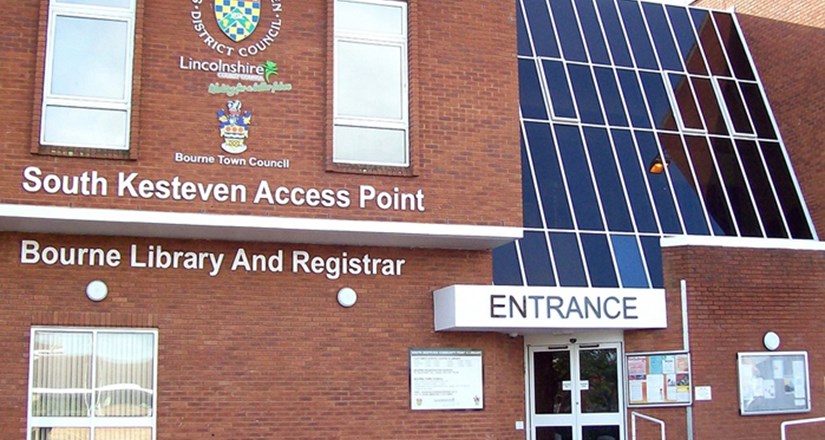History

The origins of the building date back to 1870 when grain was one of the main products from the surrounding farmland and the need for a central corn market coupled with a requirement for additional leisure facilities for a rising population persuaded local businessmen to finance a new hall to serve both purposes.
Until then, the main venues for large events were the Town Hall and the Assembly Rooms at the Angel Hotel but it was decided that purpose built accommodation was needed for an expanding town with a population of 3,850 [census 1871]. One of the prime movers was local landowner and magistrate William Parker, of Hanthorpe Hall, who outlined the importance of such a building to the town and neighbourhood at a public meeting called to discuss the project.
“There are three main advantages in the erection of such a building”, he said. “Firstly the establishment of a much needed corn exchange on a proper site, secondly the opening of a reading room and library and thirdly the provision of a suitable room for lectures and concerts which will afford instruction and rational amusement to larger numbers than can at present be accommodated in Bourne."
The Bourne Public Hall and Corn Exchange Company Limited was formed to administer the project and the directors agreed to buy a site in Church Street [now Abbey Road] then occupied by the town’s post office, from the Marquess of Exeter, Lord of the Manor of Bourne, who offered it for sale on favourable terms to help speed the development.
The architect was Mr Charles Bell of London and the contract for the construction work went to Robert Young of Lincoln in May 1870 after his tender of £1,150 was accepted. Construction work was carried out during the summer months and the corn market opened for business in October. The total cost, however, had risen to £2,000 [£202,000 by today’s values], a sum that included the purchase of the land and the fittings. The result was an unpretentious Victorian building of red brick and stone dressings with a blue slate roof.
The new Corn Exchange was soon in use by farmers and corn merchants who were doing brisk business while the new venue also became busy as a centre for social and community events, being the largest hall available in the town, able to seat 500 people. It was therefore suitable for lectures, concerts and shows from visiting theatrical companies, with other rooms devoted to billiards and reading. Ice skating as a public pastime was introduced in 1876 at a time when many rinks were being opened around the country and the facility became known as the Bourne Skating Rink in an attempt to cash in on a fashionable pastime of the period while the first film shows for Bourne were shown there in 1925.
In the summer of 1889, the Corn Exchange was struck by lightning although no serious damage was done. The weather vane, to which the point of the lightning conductor was attached, was bent, falling about five inches, and the wire was twisted throughout its length. A passer-by noticed a flash of light run from this point to the earth but no one was injured.
Corn dealing was phased out during the early years of the 20th century but the building continued in use as a social venue. The controlling company was wound up in June 1938 when it was sold to Bourne Urban District Council and under the local government re-organisation of 1976 ownership subsequently passed to South Kesteven District Council, the current administrators.
The original pyramid-style blue slate roof which can still be seen in Abbey Road marks the last remains of the old building from 1870. The Corn Exchange and its facilities were completely rebuilt in 1990, refurbished and enlarged on a much bigger site as part of a £900,000 project for the area although a stone tablet bearing the date 1870 and the town's coat of arms were incorporated in the wall of the new building which borders the pavement. The extensions at the rear of the property also created a modern façade overlooking a new paved market square and car park.
Over the years, the Corn Exchange became the major venue for social and business occasions in the town ranging from meetings of the Bourne Organ Club, regular productions by the local dramatic societies and the annual civic dinner and ball, to blood donor sessions, displays and exhibitions, and it has also been hired out for family celebrations such as wedding receptions, birthdays and christenings.
The Corn Exchange has therefore served the town well, even surviving an attempt to pull it down. In February 1969, a meeting of BUDC discussed whether the building should be sold off for a supermarket development to fund a new town drainage scheme and that future meetings and events be held in school halls but the suggestion was overwhelmingly rejected on the grounds that it had become a valuable even indispensable amenity having been let out 112 times in the previous five months.
Now it has a new lease of life as the town’s Community Access Point with all town, district and county council services gathered under one roof, together with the public library and register office. It therefore continues in regular use today and has many more valuable years of life ahead.
